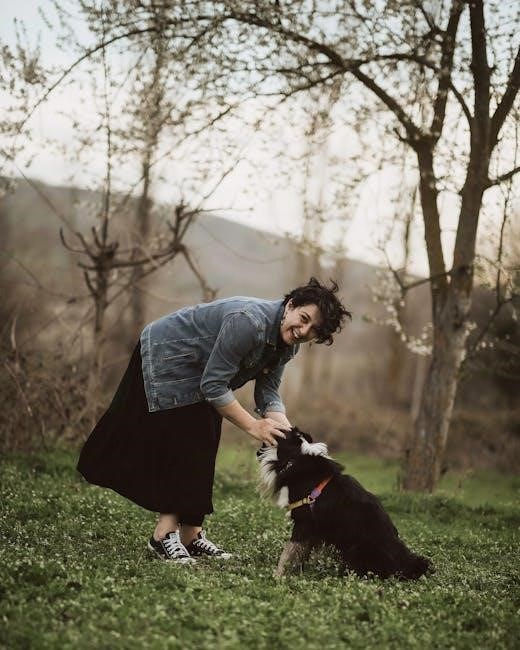The Canon EOS 5D Mark III, released in 2012, is a high-performance DSLR featuring a 22.3MP full-frame CMOS sensor, DIGIC 5+ processor, and advanced video capabilities. Designed for professionals and enthusiasts, it offers exceptional image quality, fast autofocus, and durability; The official manual provides detailed guidance on harnessing its full potential.
1.1 Overview of the Camera
The Canon EOS 5D Mark III is a high-performance DSLR camera designed for professional photographers and enthusiasts. Released in 2012, it features a 22.3-megapixel full-frame CMOS sensor, delivering exceptional image quality with detailed resolution. The camera is powered by the DIGIC 5+ image processor, ensuring fast operation and efficient noise reduction. It boasts a 61-point autofocus system, 6fps continuous shooting, and Full HD video recording capabilities. The Mark III also includes weather-sealing for durability and a 3.2-inch LCD screen for precise image review. With its robust build and advanced features, it is a versatile tool for photography and videography, catering to diverse creative needs.
1.2 Historical Significance and Release
The Canon EOS 5D Mark III was officially released in March 2012, marking a significant upgrade over its predecessor, the 5D Mark II. It introduced enhanced autofocus with 61 points, improved weather sealing, and a faster DIGIC 5+ processor. The Mark III built on the legacy of the 5D series, which revolutionized DSLR video capabilities. Its release was highly anticipated, offering photographers and videographers a robust tool for high-quality imaging. The camera’s launch solidified Canon’s position in the professional photography market, blending innovation with reliability. Its impact was substantial, making it a favorite among creatives seeking versatility and performance.
1.3 Target Audience and Use Cases
The Canon EOS 5D Mark III is designed for professional photographers and serious enthusiasts seeking high-quality images and advanced features. Its full-frame sensor and robust build make it ideal for wedding, portrait, and landscape photography. The camera’s weather sealing and durability also suit outdoor and travel photographers. Videographers benefit from its improved video capabilities, including high-resolution recording and manual controls. Additionally, its fast autofocus and burst mode make it suitable for sports and wildlife photography. This versatility ensures the 5D Mark III meets the demands of various creative workflows, catering to both stills and video professionals. Its adaptability has made it a favorite across multiple genres of photography and filmmaking.

Key Features of the Canon EOS 5D Mark III
The Canon EOS 5D Mark III features a 22.3MP full-frame CMOS sensor, DIGIC 5+ processor, 61 autofocus points, 6fps burst mode, expandable ISO up to 102400, and weather sealing.
2.1 Sensor and Image Quality
The Canon EOS 5D Mark III is equipped with a 22.3-megapixel full-frame CMOS sensor, delivering exceptional image quality with fine detail and rich tonal range. The sensor’s large size enables excellent low-light performance and shallow depth of field. Paired with the DIGIC 5+ image processor, it ensures fast processing, reduced noise, and improved color accuracy; The camera supports an expandable ISO range of 50–102400, making it versatile for both bright and low-light conditions. The sensor’s 3:2 aspect ratio and 5760×3840 pixel count provide high-resolution images, suitable for professional photography and cropping needs. Its full-frame design minimizes sensor cropping, offering a true field of view for compatible lenses.
2.2 DIGIC 5+ Image Processor
The DIGIC 5+ Image Processor is a key feature of the Canon EOS 5D Mark III, offering enhanced image processing capabilities. It provides faster operation, improved noise reduction, and superior color accuracy compared to its predecessor. The processor enables high-speed continuous shooting at up to 6 fps, ensuring quick capture of dynamic scenes. Additionally, it supports advanced in-camera processing, including HDR and multiple exposures, while maintaining fine detail and rich tonal range. The DIGIC 5+ also enhances video performance, delivering smooth, high-quality footage with reduced artifacts. Its efficient design ensures optimal battery life, making it ideal for both still photography and videography applications.
2.3 Video Capabilities and Features
The Canon EOS 5D Mark III excels in video recording, offering Full HD (1080p) capture at 24, 25, and 30 fps, as well as 720p at 60 fps. It features both ALL-I and IPB compression methods, providing flexibility in file size and quality. The DIGIC 5+ processor reduces moiré and artifacts, ensuring smoother footage. Manual audio level adjustment and a headphone jack enhance sound quality. The camera supports HDR video and timecode embedding for professional workflows. Its improved autofocus during video recording and silent controls make it ideal for filmmakers. The EOS 5D Mark III’s video capabilities cater to both enthusiasts and professionals, delivering high-quality results with advanced customization options.

Customizing Your Camera
The Canon EOS 5D Mark III allows extensive customization through Custom Functions, enabling tailored camera behavior. Users can create a personalized My Menu for quick access to frequently used settings and customize buttons for enhanced workflow efficiency.
3.1 Custom Functions Explained
Custom Functions on the Canon EOS 5D Mark III allow users to tailor camera settings to their preferences. There are 13 Custom Functions divided into four groups, covering exposure, autofocus, and more; These functions enable adjustments like setting the autofocus mode priority, customizing AE lock behavior, and configuring the metering mode. Users can modify these settings to optimize their workflow, ensuring the camera behaves as desired in various shooting scenarios. This feature is particularly useful for professional photographers who need consistent results. The Custom Functions menu can be accessed via the camera’s settings, and changes are saved for future use. Consulting the manual ensures proper configuration for individual needs.
3.2 Creating a Personalized My Menu
The Canon EOS 5D Mark III allows users to create a personalized My Menu for quick access to frequently used settings. This feature streamlines workflow by letting photographers organize up to six menu items or functions in a custom order. To set up My Menu, navigate to the camera’s menu, select “My Menu Settings,” and register desired options. Choices can include autofocus modes, metering types, or custom function settings. This customization ensures that essential tools are readily available, saving time during shoots. The My Menu can be edited or updated as needed, making it adaptable to different photography scenarios. This feature is particularly useful for professionals seeking efficiency in their workflow.
3.3 Customizing Buttons and Controls
The Canon EOS 5D Mark III offers extensive customization options for its buttons and controls, allowing photographers to tailor the camera to their workflow. Users can assign specific functions to buttons like the Multi-controller, AF-On button, and the Quick Control Dial. For instance, the shutter button can be set to activate metering or AE lock. The M-Fn button can be programmed to access frequently used functions such as RAW/JPEG toggling or depth-of-field preview. These customizations enhance operational efficiency, enabling quick access to critical settings during shoots. By personalizing button functions, photographers can streamline their process and focus on capturing the perfect shot without menu diving.

Shooting Modes
The Canon EOS 5D Mark III offers versatile shooting modes, including Manual, Aperture Priority, Shutter Priority, Program, and Bulb, providing flexibility for various photography scenarios and lighting conditions.
4.1 Manual Mode (M)
Manual Mode (M) on the Canon EOS 5D Mark III offers full control over both aperture and shutter speed, allowing photographers to fine-tune exposures for precise results. This mode is ideal for creative control and challenging lighting conditions, enabling users to adjust settings independently. The LCD panel simplifies adjustments, while the exposure compensation feature ensures balanced results. With Manual Mode, photographers can experiment with artistic effects, such as motion blur or depth of field, making it a favorite among advanced users seeking ultimate flexibility and customization in their photography.
4.2 Aperture Priority Mode (Av)
Aperture Priority Mode (Av) allows users to set the desired aperture while the camera automatically adjusts the shutter speed for a balanced exposure. This mode is ideal for controlling depth of field, making it perfect for portraits, landscapes, or macro photography. By adjusting the aperture using the rear dial, photographers can achieve a shallow focus for subject isolation or a wide depth of field for sharp backgrounds. The camera ensures accurate metering, and exposure compensation is available for fine-tuning. This mode offers flexibility while maintaining creative control over aperture settings, making it a versatile choice for various shooting scenarios.
4.3 Shutter Priority Mode (Tv)
In Shutter Priority Mode (Tv), users set the shutter speed while the camera automatically adjusts the aperture to maintain proper exposure. This mode is ideal for capturing motion, freezing fast-moving subjects, or creating artistic motion blur. Photographers can select shutter speeds from 1/8000th of a second to 30 seconds, making it suitable for sports, wildlife, or low-light photography. The camera’s metering system ensures balanced exposure, and users can fine-tune settings with exposure compensation. Additionally, Tv mode allows for creative control over the visual effects of motion, enabling photographers to emphasize speed or blur in their images. This mode is versatile and user-friendly, catering to both professionals and enthusiasts.
4.4 Program Mode (P)
Program Mode (P) is a fully automatic shooting mode where the camera controls both aperture and shutter speed to achieve optimal exposure. This mode is ideal for beginners or situations where quick adjustments are needed. While the camera handles most settings, users can still make adjustments such as exposure compensation, Auto ISO, and flash activation. Program Mode is versatile and works well in various lighting conditions, providing a balance between convenience and creativity. It’s a great starting point for those new to photography or for capturing spontaneous moments without manual adjustments. The camera’s advanced metering system ensures accurate results, making it a reliable choice for everyday shooting.
4.5 Bulb Mode (B)
Bulb Mode (B) allows for long exposures, keeping the shutter open as long as the button is pressed. This mode is ideal for capturing star trails, light painting, or other creative effects. The camera does not limit exposure time, giving full control to the photographer. It’s best used with a tripod to prevent camera shake. A remote shutter release or the self-timer is recommended to avoid vibrations. Bulb Mode is a powerful tool for capturing motion and low-light scenes, offering endless creative possibilities for photographers who want to experiment with long exposure techniques. This mode is a favorite among landscape and astrophotography enthusiasts.

Autofocus and Metering
The Canon EOS 5D Mark III features a 61-point autofocus system and multiple metering modes, including Evaluative, Center-Weighted, and Spot, ensuring precise focus and exposure control.
5.1 Understanding Autofocus Types
The Canon EOS 5D Mark III offers a sophisticated 61-point autofocus system, providing precise subject tracking. One-Shot AF is ideal for stationary subjects, while AI Servo AF excels with moving objects. The manual details how to select AF points manually or automatically, tailoring focus to your scene. Customizable AF modes ensure optimal performance in various shooting conditions, enhancing your photographic experience.
5.2 Configuring Metering Modes
The Canon EOS 5D Mark III offers four metering modes to ensure accurate exposure; Evaluative Metering analyzes the entire scene for balanced results. Center-Weighted Metering prioritizes the central area, ideal for portraits. Spot Metering measures light from a small, selectable zone, perfect for high-contrast subjects. Partial Metering covers approximately 6% of the frame, focusing on specific areas. The manual explains how to select these modes via the Metering Mode button and Quick Control Dial, allowing photographers to adapt to various lighting conditions and achieve precise exposures tailored to their creative vision.
5.3 Adjusting Exposure Compensation
Exposure compensation on the Canon EOS 5D Mark III allows fine-tuning of the camera’s metered exposure. Accessed via the Quick Control Dial, it adjusts exposure in ±3 stops in 1/3-stop increments. This feature is ideal for correcting backlit, high-contrast, or low-light scenes. Positive compensation brightens images, while negative compensation darkens them. It works in most shooting modes except Manual mode when using Auto ISO. The manual recommends using exposure compensation to preserve details in highlights or shadows. Note that adjustments apply only to JPEGs, not RAW files, providing flexibility for post-processing. This tool enhances creative control, ensuring optimal exposure tailored to specific shooting conditions.

Image Quality and File Formats
The Canon EOS 5D Mark III delivers exceptional image quality with its full-frame sensor and DIGIC 5+ processor. It supports RAW and JPEG formats, offering flexibility for post-processing.
6.1 RAW vs. JPEG: Pros and Cons
The Canon EOS 5D Mark III offers two primary file formats: RAW and JPEG. RAW files capture all image data directly from the sensor, providing maximum flexibility in post-processing. They are ideal for professional photographers who require precise control over editing. However, RAW files are larger and require more storage space. JPEG files, on the other hand, are compressed and smaller, making them convenient for sharing and storage. While JPEGs are processed in-camera and ready to use, they lack the editable data of RAW files, limiting post-processing capabilities. The choice between RAW and JPEG depends on the user’s workflow and editing needs.
6.2 Setting White Balance for Accuracy
Accurate white balance is crucial for capturing natural colors in your images. The Canon EOS 5D Mark III offers multiple white balance options, including Auto, Daylight, Shade, Tungsten, Fluorescent, Flash, and Custom. Auto White Balance automatically adjusts to lighting conditions, while preset modes like Daylight (5200K) and Tungsten (3200K) are tailored for specific scenarios. For precise control, use the Custom White Balance option by capturing a reference image of a neutral object under the lighting conditions. Additionally, you can set a specific color temperature (2500K–10000K) using the Kelvin scale. Shooting in RAW allows for flexible white balance adjustments during post-processing, ensuring optimal color accuracy in your final images.

Camera Build and Ergonomics
The Canon EOS 5D Mark III features a sturdy magnesium alloy body, weather-sealed for durability, and an ergonomic design with a 3.2-inch, 1,040,000-dot LCD screen.
7.1 Weather Sealing and Durability
The Canon EOS 5D Mark III boasts a robust magnesium alloy body, ensuring durability and resistance to harsh conditions. Its weather-sealed design protects against moisture and dust, making it ideal for outdoor and professional use. The camera’s construction is lightweight yet sturdy, with a reliable build quality that withstands heavy use. The weather sealing is applied to critical areas, including buttons, dials, and ports, to prevent water and dust ingress. This feature enhances reliability in challenging environments, such as rain or extreme humidity, allowing photographers to focus on capturing moments without worrying about equipment damage. The camera’s durability is further complemented by its ergonomic design and secure grip.
7.2 LCD Screen and Navigation
The Canon EOS 5D Mark III features a 3.2-inch LCD screen with a high resolution of 1,040,000 dots, providing crisp and detailed image previews. The Clear View II TFT display offers wide viewing angles and enhanced color accuracy. Anti-reflective coatings reduce glare, ensuring visibility even in bright conditions. Navigation is intuitive, with a responsive touchscreen interface that allows for quick adjustments and menu access. The Quick Control screen simplifies settings adjustment, while the main dial and Q button enable seamless browsing through options. These features make the camera user-friendly and efficient for professionals and enthusiasts alike.
7.3 Battery Life and Power Management
The Canon EOS 5D Mark III is powered by an LP-E6 lithium-ion battery pack, offering an impressive battery life of approximately 950 shots per charge. The camera’s power management system ensures efficient energy use, reducing battery drain during operation. For extended shooting sessions, the optional Battery Grip BG-E11 can be used, which accommodates two LP-E6 batteries or six AA batteries, effectively doubling the camera’s runtime. This feature is particularly useful for professional photographers during long shoots or remote locations. The camera also provides accurate battery level indicators, helping users monitor and manage power consumption effectively.

Additional Features
The Canon EOS 5D Mark III includes advanced features like GPS for geo-tagging images and HDR for capturing high dynamic range scenes. Multiple exposure shooting and silent modes enhance versatility. The camera also supports compatibility with the Battery Grip BG-E11, extending shooting capacity. These features make it a versatile tool for photographers seeking advanced functionality.
8.1 GPS and Geo-Tagging
The Canon EOS 5D Mark III supports GPS functionality, enabling photographers to geo-tag their images with precise location data. This feature is particularly useful for travel, landscape, and wildlife photography, where tracking shooting locations is essential. The GPS module records latitude, longitude, and altitude, embedding this information into the image metadata. To enable GPS, navigate to the camera’s menu, select the GPS settings, and turn on the feature. Note that GPS may increase battery consumption slightly. Once activated, the camera will automatically record location data for each shot, providing valuable context for your photos. This feature enhances organization and storytelling in your photography workflow.
8.2 HDR and Multiple Exposures
The Canon EOS 5D Mark III offers HDR (High Dynamic Range) and multiple exposure capabilities, enhancing creative possibilities. HDR combines three images at different exposures to capture a broader dynamic range, ideal for high-contrast scenes. Multiple exposures allow shooting up to nine images and combining them in-camera for artistic effects. Access these features via the camera’s menu, enabling HDR under the ” Shooting” tab and multiple exposures under “Multi Shot.” These tools provide photographers with advanced options for capturing detailed and creative images, making the EOS 5D Mark III versatile for various shooting scenarios and artistic expression needs.

Maintenance and Care
Regular cleaning of the sensor and mirror ensures optimal performance. Update firmware to maintain functionality and security. Handle with care to prevent damage and extend lifespan.
9.1 Cleaning the Sensor and Mirror
Regularly cleaning the sensor and mirror ensures optimal image quality and prevents dust spots. Use a hand blower or bulb blower to gently remove loose dust. For stubborn particles, dampen a sensor cleaning swab with a specialized cleaning solution and wipe in one direction. Avoid touching the mirror, as it’s delicate. Clean the exterior with a soft cloth. Perform cleaning in a well-ventilated area to minimize dust resettling. Always refer to the official manual for detailed cleaning procedures and safety precautions to maintain your camera’s performance and longevity. Proper maintenance ensures your Canon EOS 5D Mark III continues to deliver exceptional results.
9.2 Updating Firmware
Updating the firmware on your Canon EOS 5D Mark III is essential for maintaining optimal performance and accessing new features. Download the latest firmware from the official Canon website, ensuring compatibility with your camera. Connect the camera to your computer using a USB cable and use the EOS Utility software to initiate the update. Follow the on-screen instructions carefully, avoiding interruptions during the process. Once complete, restart the camera to apply the changes. Regular firmware updates enhance functionality, improve autofocus, and fix any issues. Always verify the firmware version after installation to ensure success. Visit the Canon support website for detailed guidance and the latest firmware versions.

Troubleshooting Common Issues
Resolve error messages, autofocus problems, and firmware issues by consulting the Canon EOS 5D Mark III manual or visiting the official Canon support website for solutions.
10.1 Resolving Error Messages
When encountering error messages on your Canon EOS 5D Mark III, refer to the official manual or Canon’s support website for specific solutions. Common errors include lens communication issues, memory card problems, or firmware glitches. Restarting the camera often resolves temporary glitches. For persistent errors, clean the sensor, check lens connections, or format memory cards. Updating firmware to the latest version can also fix software-related issues. Visit Canon’s official support page for detailed troubleshooting guides and downloads to ensure optimal camera performance and address any error codes effectively. Regular maintenance and updates help prevent recurring issues.
10.2 Solving Autofocus Problems
Autofocus issues with the Canon EOS 5D Mark III can often be resolved by cleaning the sensor and lens contacts. Ensure the lens is properly attached and free from debris. If problems persist, restart the camera or reset AF settings to default. For erratic AF behavior, update the camera’s firmware to the latest version. Check for specific error codes like “Err 01” or “Err 02,” which may indicate lens communication or AF motor issues. Refer to the manual or Canon’s support website for troubleshooting guides. Regular sensor cleaning and firmware updates can prevent many autofocus-related problems. Consult the manual for detailed steps to restore smooth AF performance.
The Canon EOS 5D Mark III is a powerful and versatile DSLR that excels in both photography and videography. With its 22.3MP full-frame sensor, advanced autofocus, and robust build, it remains a favorite among professionals and enthusiasts. The detailed manual provides comprehensive guidance, ensuring users can fully utilize its features. Regular maintenance and firmware updates are key to optimal performance. Whether for landscapes, portraits, or video production, the 5D Mark III delivers exceptional results. By mastering its settings and customization options, photographers can unlock its full potential, making it an indispensable tool for creative expression and professional success.

No Responses